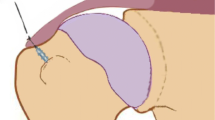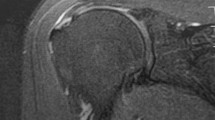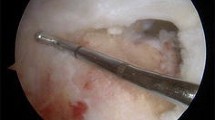Abstract
Purpose
The aim of the present study was to evaluate functional and quality of life outcomes after transosseous equivalent (TOE) double row suture technique for massive rotator cuff (RTC) tear repair using validated subjective and objective measures. This technique has shown promising preliminary results in RTC repair; however, a paucity of evidence regarding these outcomes in massive RTC (MRTC) tear repair exists.
Methods
Patients were identified using the Hospital Inpatient Enquiry Scheme. Pre-operative MRI and medical records were reviewed. A massive RTC tear was defined as the detachment of two or more tendons from their point of insertion on the humeral head. The Constant and Oxford Shoulder Scores (OSS) and SF-12 questionnaire were used for evaluation.
Results
Twenty-two patients were studied (72.7 % male; mean age at surgery, 62.6 years). Mean follow up was 14 (range six to 30) months. At six weeks postoperatively, 68 % achieved good or excellent shoulder function as measured by the OSS and Constant score. The cohort’s mean SF-12 physical and emotional scores were significantly lower (p = 0.0002 and 0.037) and the vitality and mental health scores were higher (p = 0.005 and 0.006) than the reference norm scores.
Conclusions
The TOE double row surgical repair for MRTC tears provides good to excellent functional outcomes and is associated with high vitality and mental health scores at a mean of 14 months. Physical and emotional scores were lower than reference norm. These results suggest this repair technique is appropriate for massive rotator cuff tears, and future randomised control studies are warranted.




Similar content being viewed by others
References
Matsen FA, Arntz CA, Lippitt SB (1998) Rotator cuff. In: Rockwood C (ed) The Shoulder, 2nd edn. WB Saunders, Philadelphia, pp 755–839
Kim DH, El Attrache NS, Tibone JE et al (2006) Biomechanical comparison of a single-row versus double-row suture anchor technique for rotator cuff repair. Am J Sports Med 34:407–414
Mazzocca AD, Millett PJ, Guanche CA et al (2005) Arthroscopic single-row versus double row suture anchor rotator cuff repair. Am J Sports Med 33:1861–1868
Park JY, Lhee SH, Choi JH, Park HK, Yu JW, Seo JB (2008) Comparison of the clinical outcomes of single and double row repairs in RTC tears. Am J Sports Med 36:1310–1316
Meier SW, Meier JD (2006) The effect of double-row fixation on initial repair strength in rotator cuff repair: A biomechanical study. Arthroscopy 22:1168–1173
Sugaya H, Maeda K, Matsuki K, Moriishi J (2007) Repair integrity and functional outcome after arthroscopic double row rotator cuff repair. A prospective outcome study. J Bone Joint Surg Am 89(5):953–960
Galatz L, Ball CM, Teefey SA, Middleton WD (2004) The outcome and repair integrity of completely arthroscopically repaired large and massive rotator cuff tears. J Bone Joint Surg Am 86:219–224
Constant CR, Murley A (1987) A clinical method of functional assessment of the shoulder. Clin Orthop Relat Res 214:160–164
Dawson J, Fitzpatrick R, Carr A (1996) Questionnaire on the perceptions of patients about shoulder surgery. J Bone Joint Surg (Br) 78(4):593–600
Murray DW, Fitzpatrick R, Rogers K, Pandit H, Beard DJ, Carr AJ, Dawson J (2007) The use of the Oxford hip and knee scores. J Bone Joint Surg (Br) 89-B:1010–1014
Ware J, Kosinski M, Keller S (1998) SF-12. How to score the SF-12 Physical and Mental Health Summary Scales (Third Edition). QualityMetric Incorporated, Lincoln, RI
Ware JE Jr, Kosinski M, Keller S (1996) A 12 Item Short Form Health Survey construction of scales and preliminary tests of reliability and validity. Med Care 34:220–233
Gandek B, Ware JE, Aaronson NK, Apolone G et al (1998) Cross validation of item selection and scoring for the SF 12 Health Survey in nine countries; results from the IQOLA project. J Clin Epidemiol 51:1171–1178
Hanusch BC, Goodchild L, Finn P, Rangan A (2009) Large and massive tears of the rotator cuff: functional outcome and integrity of the repair after a mini-open procedure. J Bone Joint Surg (Br) 91(2):201–205
Lam F, Mok D (2004) Open repair of massive RTC tears in patients aged sixty five years or over: is it worthwhile? J Shoulder Elbow Surg 13:517–521
Nho SJ, Adler RS, Tomlinson DP, Allen AA, Cordasco FA, Warren RF (2009) Arthroscopic rotator cuff repair: prospective evaluation with sequential ultrasonography. Am J Sports Med 37:1938–1945
Toussaint B, Schnaser E, Bosley J, Lefebvre Y, Gobezie R (2011) Early structural and functional outcomes for arthroscopic double-row transosseous-equivalent rotator cuff repair. Am J Sports Med 39(6):1217–1225
Bassey EJ, Morgan K, Dallosso HM, Ebrahim SB (1989) Flexion of the shoulder joint measured as range of abduction in a large representative sample or men and women over 65 years of age. Eur J Appl Physiol 58:353–360
Chakravarty K, Webley M (1993) Shoulder joint movement and its relationship to disability in the elderly. J Rheumatol 20:1359–1361
Cofield RH, Parvizi J, Hoffmeyer PJ, Lanzer W, Ilstrup DM, Rowland CM (2001) Surgical repair of chronic RTC tears. A prospective long-term study. J Bone Joint Surg Am 83:71–77
Gerber C, Wirth S, Farshad M (2011) Treatment options for massive RTC tears. J Shoulder Elbow Surg 20:20–29
Romeo A, Hang D, Bach B, Shott S (1999) Repair of full thickness RTC tears. Gender, age, and other factors affecting outcome. Clin Orthop Relat Res 367:243–255
Vaishnav S, Millett PJ (2010) Arthroscopic rotator cuff repair: Scientific rationale, surgical technique, and early clinical and functional results of a knotless self-reinforcing double-row rotator cuff repair system. J Shoulder Elbow Surg 19:83–90
Miškulin M, Vrgoč G, Sporiš G, Dulic O, Gavrilovic G, Milanović Z (2015) Single-row arthroscopic cuff repair with double-loaded anchors provides good shoulder function in long-term follow-up. Int Orthop 39(2):233–240
Burkhart S, Adams C, Burkhart S, Schoolfield J (2009) A biomechanical comparison of 2 techniques of footprint reconstruction for rotator cuff repair: the SwiveLock-FiberChain construct versus standard double-row repair. Arthroscopy 25(3):274–81
Author information
Authors and Affiliations
Corresponding author
Rights and permissions
About this article
Cite this article
Connelly, T.M., Shaw, A. & O’Grady, P. Outcome of open massive rotator cuff repairs with double-row suture knotless anchors: case series. International Orthopaedics (SICOT) 39, 1109–1114 (2015). https://doi.org/10.1007/s00264-015-2720-z
Received:
Accepted:
Published:
Issue Date:
DOI: https://doi.org/10.1007/s00264-015-2720-z




